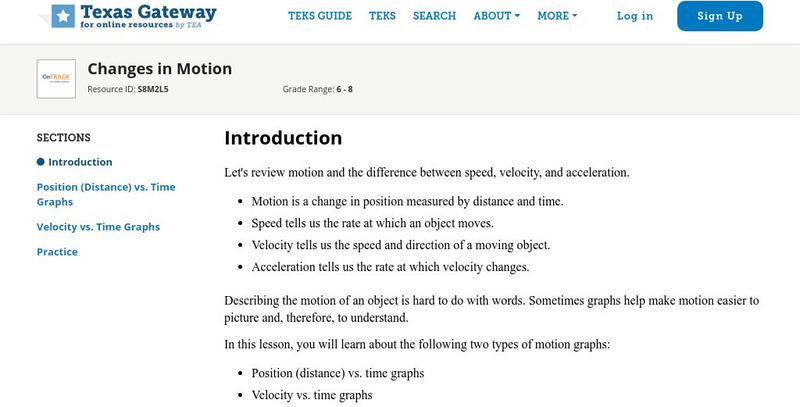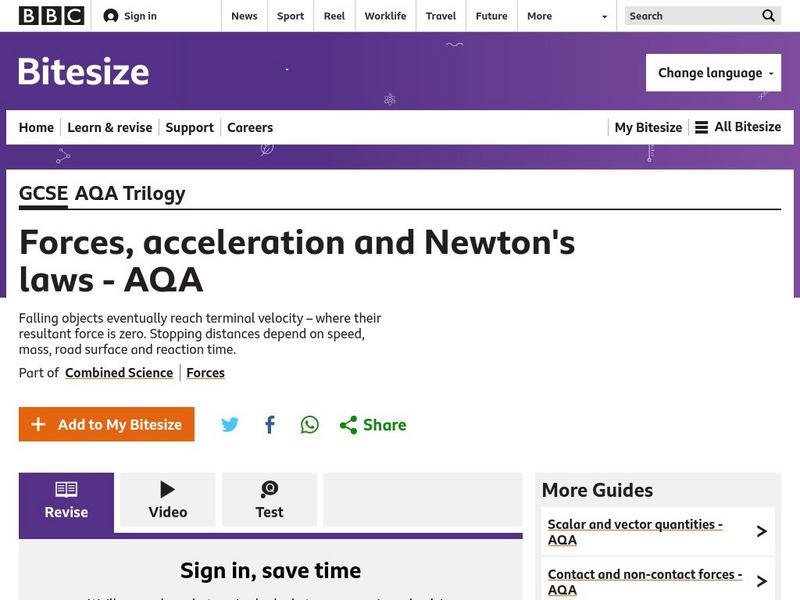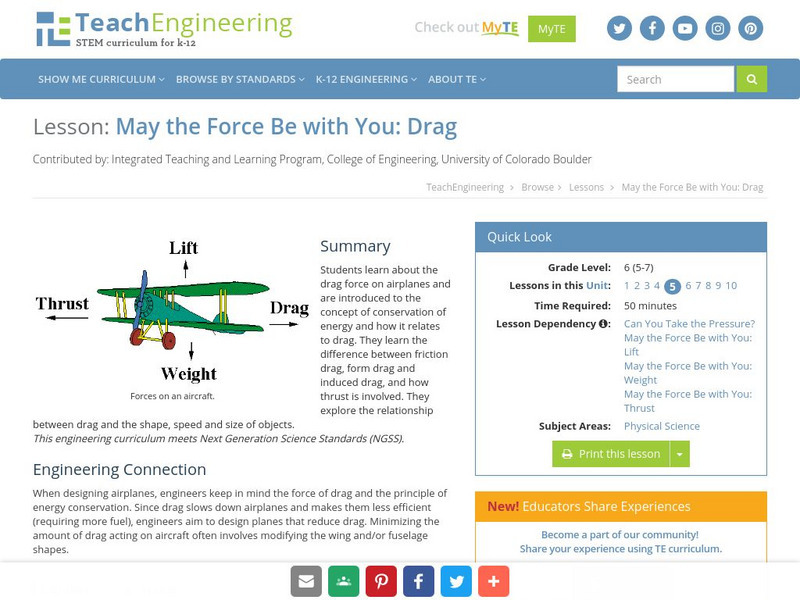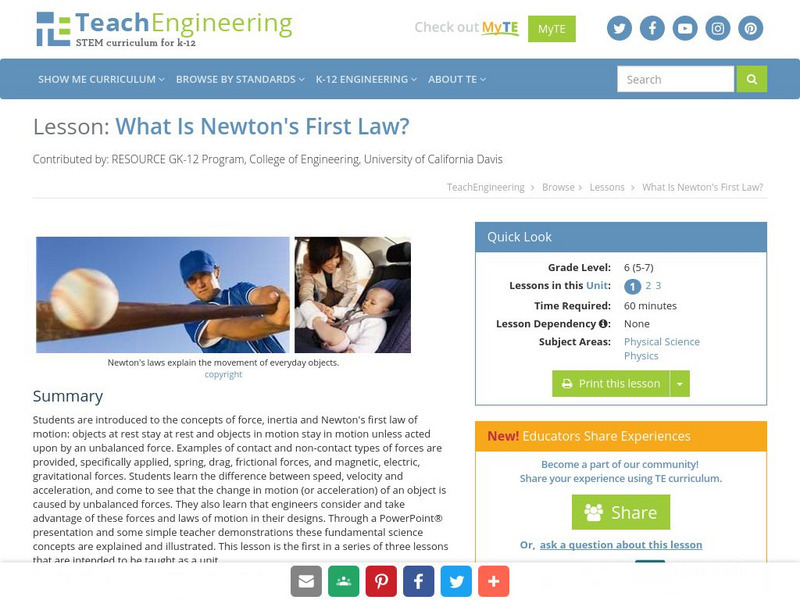Physics Aviary
Physics Aviary: Practice Problems: Motion on Incline Level 1
Students must calculate the distance an object will move up an incline using Newton's Laws. Mass, angle, gravitational field and initial speed will be generated randomly.
Texas Education Agency
Texas Gateway: Changes in Motion
In this lesson, you will learn about position vs. time graphs and velocity vs. time graphs and how to use them to solve problems.
Physics Classroom
The Physics Classroom: Satellite Motion
An animation depicting the path of projectiles launched at various launch speeds from the fictional Newton's Mountain. Accompanying text discusses satellite motion and the requirements of orbital motion. Links to further information is...
Physics Classroom
The Physics Classroom: Circular and Satellite Motion:circular Motion Mathematics
Using the values of speed, acceleration, and force, students explore and analyze the motion of objects in circles.
Physics Classroom
The Physics Classroom: Circular & Satellite Motion: Uniform Circular Motion
Manipulate variables while exploring principles and relationships related to moving in a circle at a constant speed. Students change the radius of the circle, the speed of the object, and the mass of the object and investigate the effect...
Physics Aviary
Physics Aviary: Practice Problems: Vertical Motion of Firework Level 4
Students will set the launch speed and fuse time for a firework so that the firework will explode at the desired height and speed. This problem does not take place on Earth.
Physics Aviary
Physics Aviary: Practice Problems: Motion on Incline Level 3
Students must calculate the speed of a block when it returns to its original location on an incline using Newton's Laws. Mass, angle, gravitational field, coefficient of friction and initial speed will be generated randomly.
Physics Aviary
Physics Aviary: Practice Problems: Motion on Incline Level 2
Students must calculate the distance an object will move up an incline using Newton's Laws. Mass, angle, gravitational field, coefficient of friction and initial speed will be generated randomly.
Other
Ward's Science: Speedy Energy
This is an interactive inquiry where students will investigate the speed of an object and the energy it exerts as it crashes into other objects. Students will understand that the more speed an object has, the more energy it has in a...
Better Lesson
Better Lesson: Collision Course (Part 2)
This is part 2 of a two-part lesson on understanding how speed changes when two objects collide. Students will conduct an experiment, collect data, and draw conclusions about the changes in energy that occur when objects collide....
Walter Fendt
Walter Fendt: Uniform Circular Motion
This app simulates circular movement and demonstrates how the position, speed, acceleration, and the applied force vary depending on the time. You may choose the option "slow animation" to make the movement ten times slower. You can also...
Physics Classroom
The Physics Classroom: Circular, Satellite, Rotational: Uniform Circular Motion
Uniform circular motion can be described as the motion of an object in a circle at a constant speed. This animation depicts this by means of a vector arrow.
BBC
Bbc: Gcse Bitesize: Forces, Acceleration and Newton's Laws Aqa
This lesson focuses on Newton's First Law: an object remains in the same state of motion unless a resultant force acts on it. If the resultant force on an object is zero, this means: a stationary object stays stationary; a moving object...
Texas Instruments
Texas Instruments: Slow Down: Speed Up
In this activity, students' will use a motion detector to observe the effect of speeding up, slowing down, and moving at a constant rate on a Distance versus Time plot.
Physics Classroom
The Physics Classroom: Mathematics of Satellite Motion
The mathematics associated with the motion of satellites is described. Equations (for period, velocity, acceleration and force) are stated, symbols described, and sample problems solved. Includes five practice problems with solutions and...
Science Education Resource Center at Carleton College
Serc: Centripetal Force Activity
In this physics activity, students will simulate a race car on a circular track. Velocity, acceleration, and force vectors will be analyzed at various places along the track. As the students progress in the activity, prompts for student...
TeachEngineering
Teach Engineering: May the Force Be With You: Drag
This lesson explores the drag force on airplanes. The learners will be introduced to the concept of conservation of energy and how it relates to drag. Students will explore the relationship between drag and the shape, speed and size of...
TeachEngineering
Teach Engineering: What Is Newton's First Law?
Students are introduced to the concepts of force, inertia, and Newton's first law of motion: objects at rest stay at rest and objects in motion stay in motion unless acted upon by an unbalanced force.This activity is the first in a...
Other
Westerville District: Measuring Motion
Learn about motion and how it is defined by a reference point.
Middle School Science
Middle School Science: Motion Notes
Personal site in which a teacher outlines a unit on motion. Probes through topics such as average speed, velocity, acceleration, speed, deceleration, force and more.
Middle School Science
Middle School Science: Motion Crossword Puzzle
Let your students have a little fun and reinforce their learning of motion-related concepts at the same time.
CK-12 Foundation
Ck 12: Physical Science: Position Time Graphs
[Free Registration/Login may be required to access all resource tools.] How motion and speed can be represented by a distance-time graph and how average speed can be calculated from it.
Physics Classroom
The Physics Classroom: Newtons Laws: Rocket Sledder Interactive
Experience the effect of friction, air resistance, and applied force upon a sledder. The speed, acceleration, and force values are displayed as the sled moves. Learners can vary the mass of the sledder and the size of the parachute...
Physics Aviary
Physics Aviary: Drone Delivery Challenge
Land as many objects as close to the target as possible. More points will be earned if the height is high and the speed is fast.











